We made the world's smallest sonar modem
Greetings to you, our dear habread reader!
"Thus the Spirits diminished and the palaceAdherents of the dark kagala of underwater communication and navigation work day and night to bring this very underwater communication and navigation to the masses, and today one of them, as promised, will report on the work done and the progress achieved.
Holds odd swarms
Spacious. "
(C) John Milton, Lost Paradise

So, it seems to me this time we have reached the physical limit and most likely it is impossible to make a device for transmitting digital data by sound through the water at a distance of 1000 meters any less noticeably.
')
Who was excited by the theme - forward, to the hydroacoustic abundance, under the cat!
Traditionally realizing that the topic of hydroacoustic communication and related problems is far from familiar to everyone, I propose a set of ours (and not only)
previous articles
Session video transmission sound through the water with the exposure
Underwater GPS from scratch for the year
Underwater GPS: continued
Underwater "GPS" on two transceivers
On the effect of cyanobacteria on the speech functions of the president
Navigation under water: pelenguy - not pelenguy, you are doomed to success
And also with a great review article @akuzmin about hydro-acoustics
Underwater GPS from scratch for the year
Underwater GPS: continued
Underwater "GPS" on two transceivers
On the effect of cyanobacteria on the speech functions of the president
Navigation under water: pelenguy - not pelenguy, you are doomed to success
And also with a great review article @akuzmin about hydro-acoustics
I will briefly mention that here we have 95% of the ocean remains unexplored, and the difficulty is not only that we can
Mankind is trying to get out, and today the only more or less widespread alternative to radio communications under water is acoustics, or more precisely hydroacoustics. With the help of sound waves, which by the way, spread in the water five times faster than in the air:
- exchange voice messages . Voice messaging devices are among the simplest and quite common in narrow circles. Engaged in the development, for example, OTS , OceanReef , and since last year we ;
- Bearing and locating underwater objects using long-range navigation systems ;
- Engaged in shooting the bottom, search for fish and various submarines;
And just transmit digital data, while often nowadays it is a good idea to combine data transmission with navigation.
Devices with the help of which digital data is transmitted through water is called (oddly enough) hydroacoustic modem.
Transmitting data by sound through the water is difficult, but you can
To understand why this is difficult, imagine that you are looking through a babbling brook at a newspaper lying on the bottom and are trying to read it. All that you can make out through the running ripples and glare - the title. Strongly straining your eyes, you may be able to sort out (even, rather, guess) the text of the subtitles, but you will understand what is written in the columns with great luck, when the ripples are smooth for a moment and a thin layer of laminar water flows between the eye and the text.
Sound in water propagates nonlinearly, undergoing bending (refraction), reflection, addition and subtraction of reflected copies of a signal (reverberation and multipath propagation), Doppler shift as well as stretching and compression of the spectrum.
Following our analogy, the larger the heading is, the easier it is to read, that is, the lower the transmission speed - the more reliable the connection is, in general, the “guess” that is written in a smaller text can be compared with noise-resistant coding (this takes time and additional information) , and read a very small text can only be in good conditions.
People close to radio communication will rightly notice that all the difficulties listed are inherent in varying degrees and radio channels, but the main differences are that in hydroacoustics for data transmission, a band is available somewhere from 5 to 100 kHz with a very big stretch ( in reality, it is noticeably less), and control to the head: if (plus or minus) to transmit data in the 5-15 kHz band, having worked hard for 10–20 km, then in the 80–100 kHz band, it is possible to reach a range of 1 km with a fair fractions of luck, which is associated with a strong non-uniformity of attenuation I have sound waves of different frequencies.
Well, yes, the speed of sound is a little less than the speed of light - only 200,000 times.
To illustrate the capabilities of modern hydroacoustic modems, here is a dissertation tablet (page 54 for PDF) of Bridget Benson, which is very popular among those who
| Manufacturer | Modem | Band, kHz | Power consumption (transmission), W | Range, km |
|---|---|---|---|---|
| Aquatec | AQUAModem | 8-16 | 20 | ten |
| DSPComm | Aquacomm | 16-30 | varied | 3 |
| Tritech | Micronmodem | 20-24 | 7.92 | 0.5 |
| WHOI | Micromodem | 25 | 50 | 1-10 |
| Benthos | ATM885 | 16-21 | 28-84 | 2-6 |
| EvoLogics | S2CM48 / 78 | 48-78 | 2.5-80 | one |
| Linkquest | UWM2000H | NS | 1.5 | 0.8 |
| UCSD | UCSDModem | 40 | 1.3-7.0 | 0.4 |
| Manufacturer | Modem | Power consumption (reception), W | Modulation | Baud rate, bps | Price, $ |
|---|---|---|---|---|---|
| Aquatec | AQUAModem | 0.6 | DSSS | 300-2000 | 7600 |
| DSPComm | Aquacomm | varied | DSSS / OFDM | 480 | 6600 |
| Tritech | Micronmodem | 0.72 | DSSS | 40 | 3500 |
| WHOI | Micromodem | 0.23 / 2 | FSK / PSK | 80/5400 | 8100-9400 |
| Benthos | ATM885 | 0.7 | FSK / PSK | 140-15360 | 7200-11000 |
| EvoLogics | S2CM48 / 78 | 0.5 | S2c | 15,000 | 12500 |
| Linkquest | UWM2000H | NS | Proprietary | 9600 | 7,000 |
| UCSD | UCSDModem | 0.42 | FSK | 200 | 350 * |
What has changed since 2010? Benthos was purchased by Teledyne, Aquatec no longer does an acoustic modem (now it only does optically at a distance of 1 meter), and EvoLogics modems, according to rumors that have reached me, have dropped in price significantly. But the most global change from my point of view happened quite recently: hydroacoustic modems appeared on alibab-e. Priced around $ 1000- $ 2000 each. In China, there is technology, and most likely it has moved into the category of civilians. The gentlemen from the tablet accept new members to their ranks.
But while slow Chinese manufacturers have just released devices priced at $ 1,000- $ 2,000 apiece, experienced DSPComm with modems from $ 6,600 have long written on their website that their goal is modems cheaper than $ 1,000.
People try to make a cheap sonar modem.
And the key word here is “cheap” - you just need to score in Google “Low cost underwater acoustic modem”. If we discard the pile of theses, suspiciously closely repeating the thesis of B. Benson, there will still be a sufficient number of interesting projects. An interesting generalization in my opinion was made by the Spanish comrades. In many ways, very honest, without any special attempts to embellish something.
But back to the topic of the article.
The above-mentioned Chinese products scare with their thoroughness: F120x600, weight 12 kg, 40 watts of the transmitter push data at speeds from 140 to 1200 bps at a distance of up to 20 kilometers. With regards to the transmission rate - I recommend always to look at the lower limit of the range.
The smallest (and cheapest) modem from those shown in the tablet is MicronModem from the English spin-off of the New Castle University company with dimensions of F56x79 mm, dry weight 235 grams and according to the manufacturer can transfer user data at 40 bps distance up to 500 meters.
Not bad, but in 2016 we released our RedLINE , which, with dimensions of 64x62 mm and a dry weight of 360 grams, can transmit digital data at a speed of 80 bit / s to a distance of up to 8000 meters, while standing much cheaper than its competitor, and even with a relay function. In many ways, so tightly packaged "spirits in the palace" happened thanks to the efforts of StDmitriev , and a little bit of mine. Our idea then took shape in a whole patent .
Running back
Let us ask ourselves, what does the modem consist of? As a rule, from a transceiver antenna made of one or several piezoceramic rings, a power amplifier, a preamplifier and filters, as well as some kind of digital signal processor. It seems not rocket science? But after all, in a rocket, the cost of all materials and aggregates is only less than 10% of the cost of the rocket itself.
While technology has not gained mass status - it remains expensive.
And we want to buy a hydroacoustic modem was no more difficult than to buy an Arduino, GPS or radio module.
What are we doing for this? Continuing to exploit our patent, StDmitriev this time "pushed the spirits" into an even smaller size palace, and I, respectively, wrote down a new firmware that could take full advantage of the resulting record hardware.
Meet uWAVE - the smallest and cheapest sonar modem in the world

Now the spirits are cramped in a cylinder of size F40x45 millimeters, the weight of which does not exceed 160 grams. Hissing spirits allows you to transfer data at a speed of 78 bps over a distance of 1000 meters. And the modem itself can be powered even from USB.
The following photo size comparison of RedLINE (yellow) and uWAVE (red):
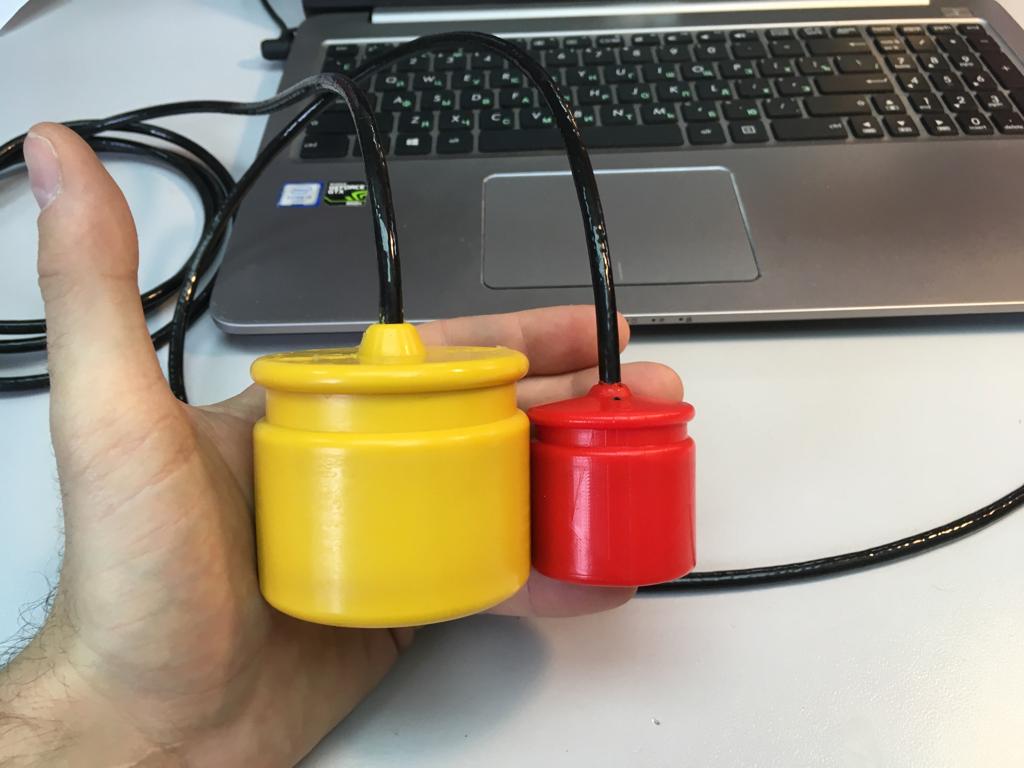
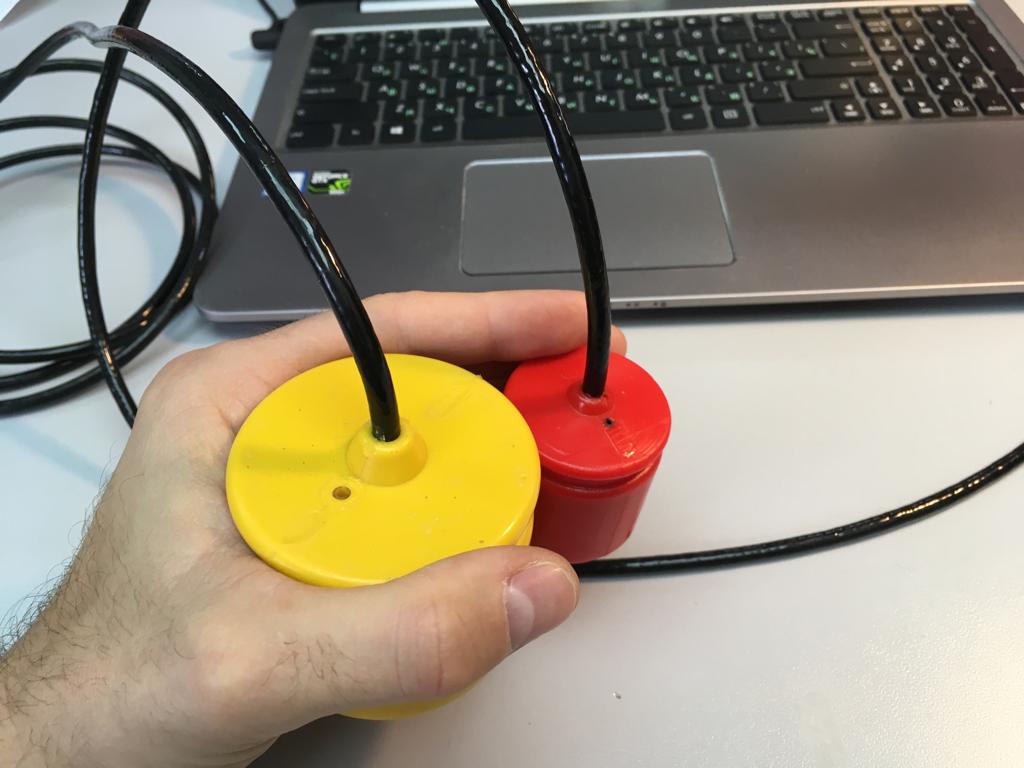
But this is not all: the modem supports not only the transmission via so-called. transparent channel with code division of subscribers, but also a command mode in which you can remotely request the depth, temperature (there is an integrated sensor on board) and the power supply of the remote subscriber with measurement of the propagation time of the signal. And for the tasks of telecontrol 9 code user commands are provided.
But even this is not the main thing, but the main thing is that we managed to beat our own price record and the retail price for the uWAVE modem is $ 480. This is 6 (SIX, KARL!) Times cheaper than the nearest English equivalent, with twice the range, and half the size. We neatly hope that with an increase in production volumes, the price can be further lowered.
As you can see, we met the expectations of 7.6% of those who voted in the previous article , and this price range ranks second in the vote after the still unattainable $ 100- $ 200.
If someone can now be less and cheaper with the same characteristics - I give you my word: immediately leave the profession!
When I said that we reached the
And why is all this necessary?
“Didn’t billions of unknown skeletons in unknown graves called to us, demanded and reproached? I see billions of past human lives, in which, like sand between fingers, instantly flowed away youth, beauty and the joys of life - they demand to solve the great mystery of time, to join the fight with it! The victory over space is the victory over time - that is why I am sure that I was right and in the greatness of the planned business! ”(C) I. Efremov, Andromeda Nebula
“In the first place, it's just beautiful ...” (C)
If it is serious, then recently the topic of communication with a flock of autonomous vehicles, the underwater Internet of things, and other incredible things is especially in demand. Here, colleagues make very different size autonomous vehicles (gliders) on which to place a product of Chinese industry weighing 12 kilograms is not that problematic, but a little impossible, and it is especially hard to feed it with the forces of this apparatus, for example, take a look at this kid
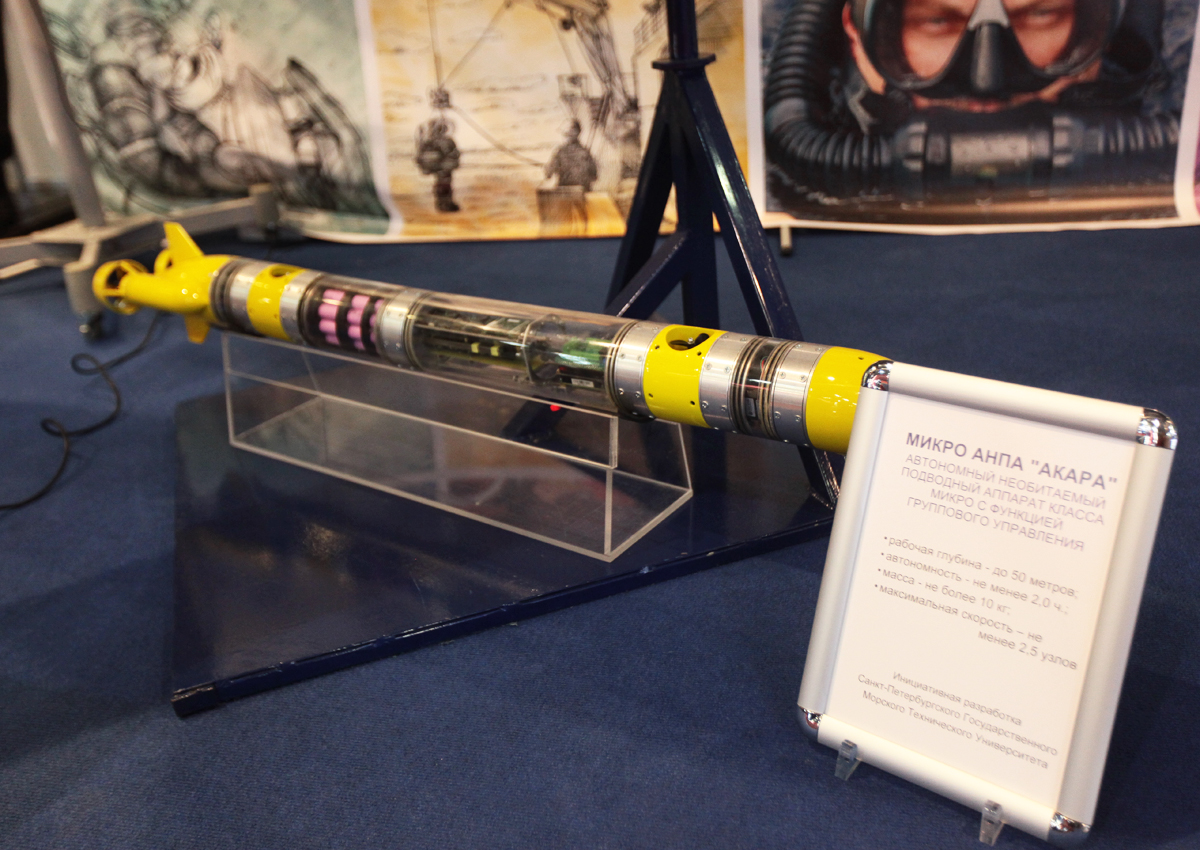
On yummy
I want to tell how we repeated the experience from the previous article , where we determined the geographical location of one of the RedGTR modems using another similar modem, GPS module and Chinese radio bait boat.
I quickly rewrote the application so that it could work with uWAVE modems, and the onboard firmware of the boat did not even have to be changed. Interface protocol with modems made even easier.
Due to lack of time, we did not go to our beloved Pichugu , but were content with a backup option - the South pond , a familiar reservoir, with a depth of 2 to 1.5 meters.
This time the “lighthouse” was located on a raft of solid thermal insulation, and was powered by Power Bank, as can be seen in the photo:

Loading a raft with a lighthouse on a boat:

Work moment:

In general, everything was expectedly earned and in the end we got a couple of tracks with an accuracy of better than 1 meter. Like this:
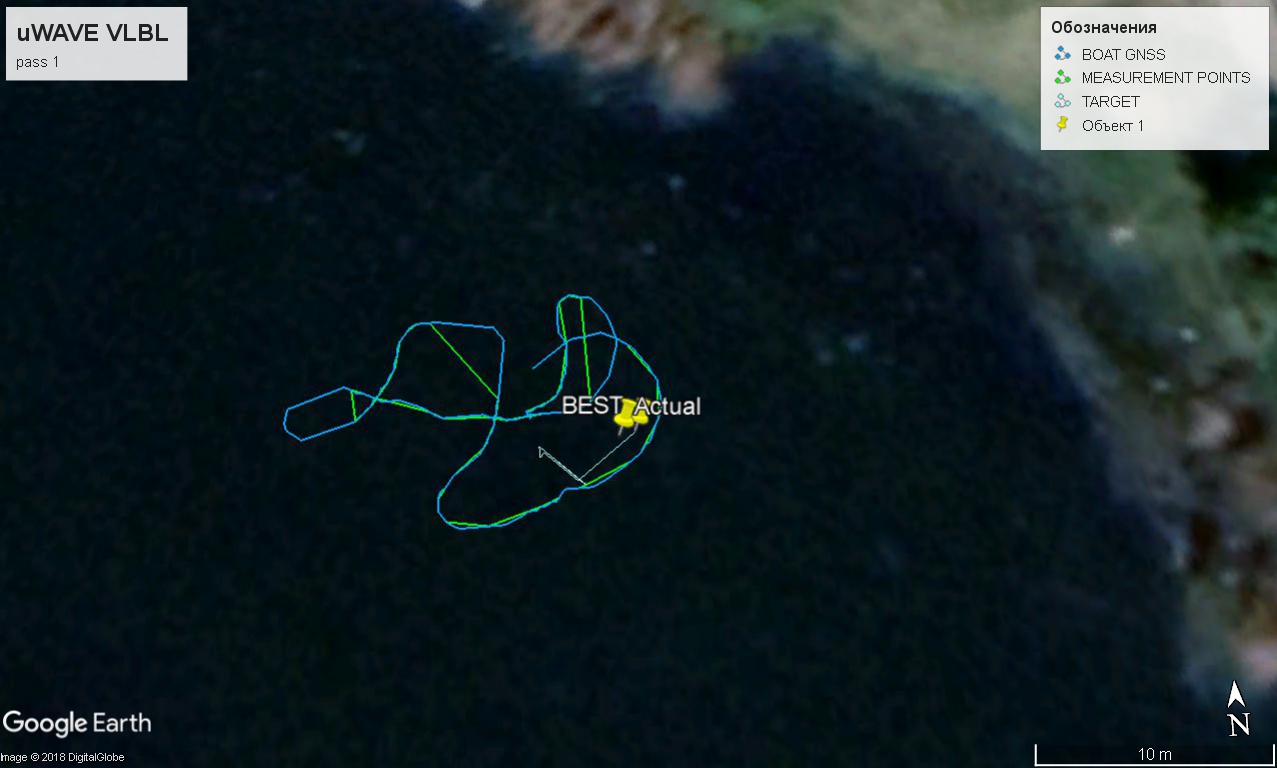
And so:
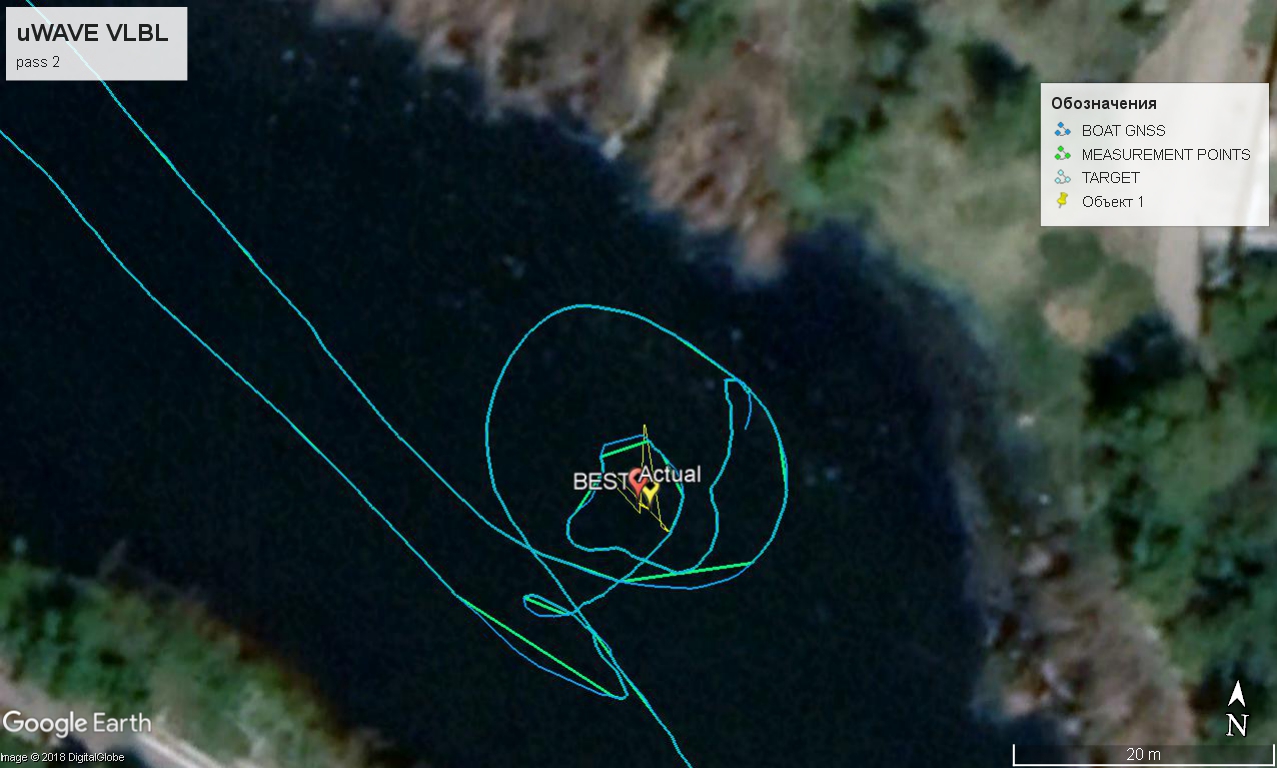
In the photo above is an enlarged part of the track, and the whole of it is in view of the length of the reservoir in the following photo:
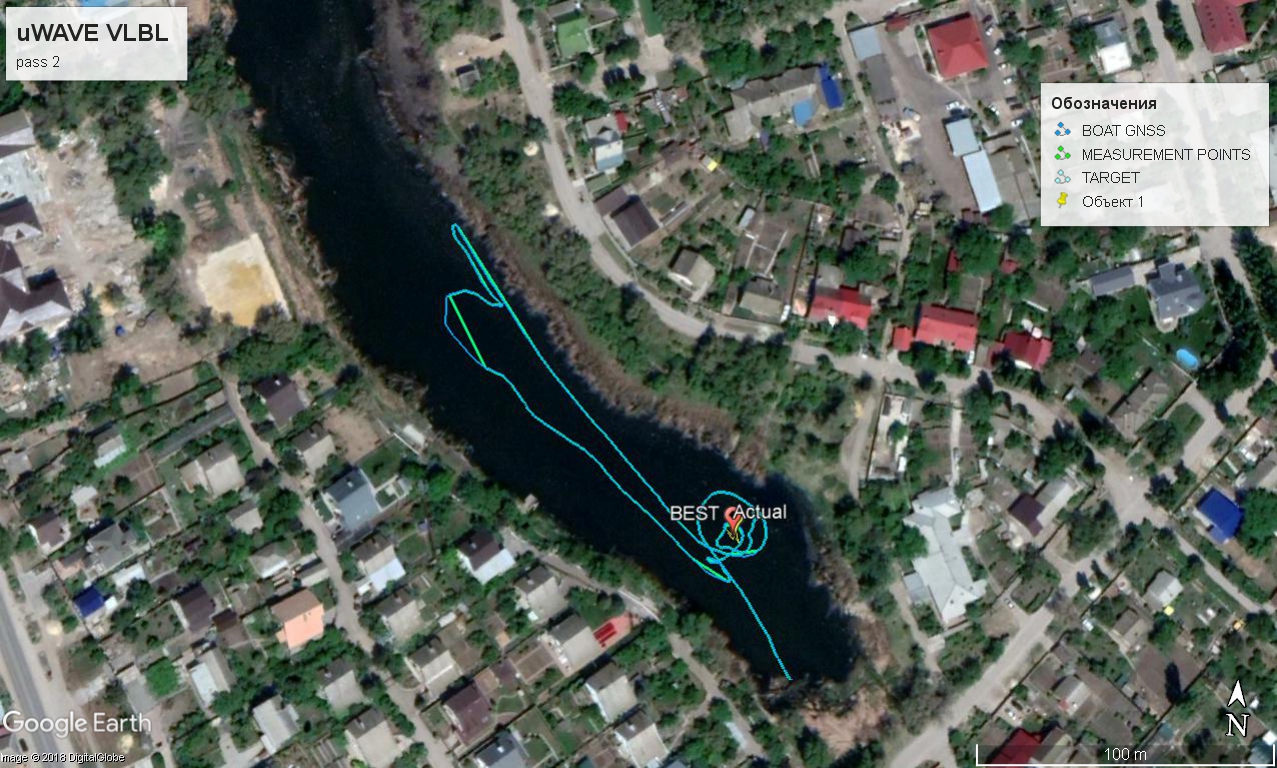
Green shows the measurement track - the points where the distance to the respondent was measured, and where it is lagging behind the blue (the track of the boat) the acoustic connection was broken. The reason for this is quite simple and banal - the hydrological conditions are such that hardly anyone other than
In both cases, we got a deviation from the real position of the lighthouse in the region of 70-90 centimeters.
This is how it looks on the console application screen:

The modem on the boat is powered by a lead battery, its voltage as well as the depth and propagation time are displayed on the upper left, the modem - the "respondent" was powered by a Power bank, its voltage is expected to be 5 volts and 80 cm deep. C, and according to the respondent, 13.8 ° C.
From the prospects associated with this branch of devices
- we plan to make a direction finding antenna for working with uWAVE;
- firmware for the long-base system is already ready, in which the uWAVE modem will act as a pinger, and its location can be determined with the help of four small buoys. As soon as we get rid of the current tasks, we will develop the enclosures and boards.
Finally
Thank you for your attention, as always, reasonable criticism and suggestions are welcome!
PS
And he is so cool, small =)
We got real pleasure in the process of developing our very modem itself, this is one of those moments for which we work.
Pps
The success of the company noted tea drinking, not getting out of the kayak.

Source: https://habr.com/ru/post/428367/
All Articles